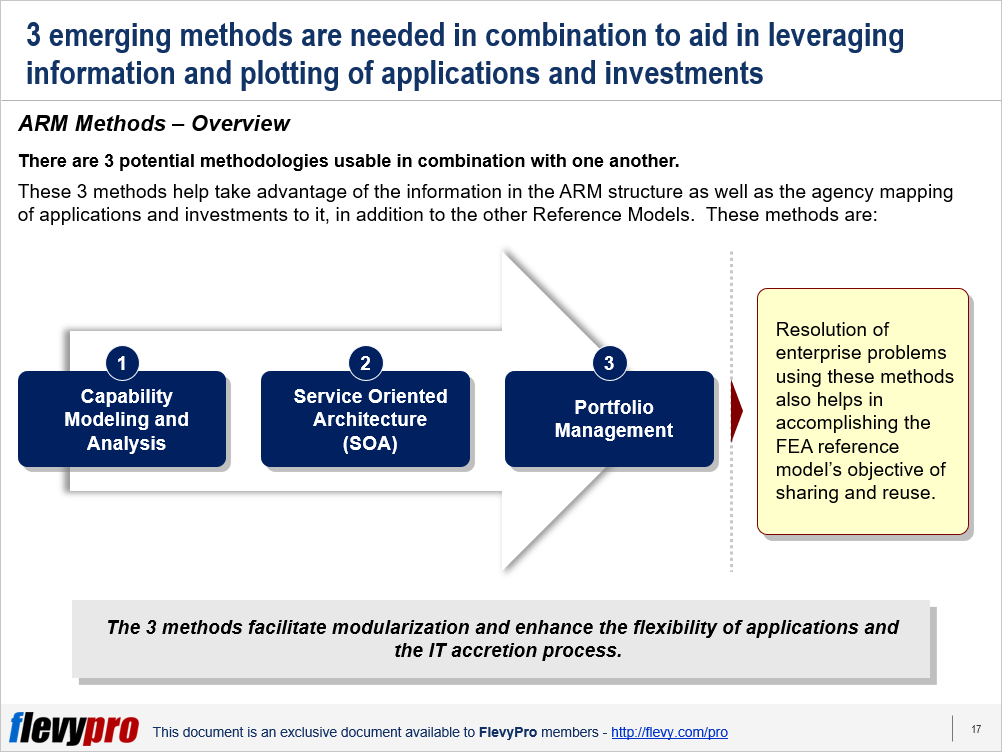Business and technology resources are lined up by employing Enterprise Architecture (EA) so as to realize strategic results, augment organizational performance, and direct departments to meet their key missions more effectually and achieve Operational Excellence.
Federal Enterprise Architecture Framework (FEAF) achieves these objectives for any U.S. federal agency and aids systems exceed interagency boundaries.
The FEAF comprises of 6 interconnected Reference Models, each relating to a sub-architectural domain of the framework.
Here, we deliberate on 1 of the 6 reference models of the Federal Enterprise Architecture Framework—the Application Reference Model (ARM). ARM sets the foundation for categorizing software applications and their components.
Through the implementation of ARM, we can achieve a number of positive outcomes throughout the enterprise. Mapping of existing and future information systems to ARM categorizations assists in detecting gaps and redundancies. Gap detection helps identify occasions for sharing, reuse, and merging or renegotiation of licenses. Gap information is used in conjunction with other models to identify opportunities.
ARM has been based on guiding principles that emanate from Common Approach to Federal EA with further refinement based on the purpose and desired outcomes of the Application Reference Model. The principles are:
- ARM should be based on the Separation of Concerns principle i.e., founded on an adaptive structure that permits addition of new methods of providing IT capabilities.
- Definition of ARM should be with reference to applications supplied within the Service Oriented Architecture enabling facilitation of shared services and interoperability.
- Definition of ARM should be in terms of a hierarchy of broadly paired IT application components.
- ARM ought to be standards based along several levels of abstraction to circumvent vendor lock-in, under permitting circumstances.
- Ascertained touch points should enable ARM to back the Business Reference Model (BRM) and the Data Reference Model (DRM).
ARM contains 3 levels in its structure: Systems, Application Components, and Interfaces. ARM is also strongly connected with the rest of the 5 reference models of the Consolidated Reference Model Framework. More on that in the FEAF: Application Reference Model presentation.
ARM uses 3 potential methodologies in combination with one another to assist in taking advantage of information and strategizing of applications and investments:
- Capability Modeling and Analysis
- Service Oriented Architecture (SOA)
- Portfolio Management
These 3 methods help take advantage of the information in the ARM structure as well as the agency mapping of applications and investments to it, in addition to the other Reference Models.
Let us dive a little deeper into these methods.
Capability Modeling and Analysis
Capability Modeling and Analysis is a requirements analysis technique that converts business or mission as well as technical requirements into distinct competencies that assist in sharing and reuse analysis.
Instead of employing standard requirement or business process analysis techniques, breaking down requirements into detailed capabilities, and modeling the capability dependencies, leads to a clearer picture regarding commonality of requirements.
Service Oriented Architecture (SOA)
For assembly of IT solutions, a collection of interacting services enables an architectural style—SOA—a layered diagram that depicts the services and their dependencies. SOA offers extra application flexibility due to ease of modification and replacement of services.
Portfolio Management
Portfolio management techniques are employed to gauge assets for feasibility of use in future and to mature a service lifecycle plan for each asset thus promoting reuse and sharing of services.
Interested in learning more about the Application Reference Model (ARM)? You can download an editable PowerPoint on FEAF: Application Reference Model (ARM) here on the Flevy documents marketplace.
Do You Find Value in This Framework?
You can download in-depth presentations on this and hundreds of similar business frameworks from the FlevyPro Library. FlevyPro is trusted and utilized by 1000s of management consultants and corporate executives. Here’s what some have to say:
“My FlevyPro subscription provides me with the most popular frameworks and decks in demand in today’s market. They not only augment my existing consulting and coaching offerings and delivery, but also keep me abreast of the latest trends, inspire new products and service offerings for my practice, and educate me in a fraction of the time and money of other solutions. I strongly recommend FlevyPro to any consultant serious about success.”
– Bill Branson, Founder at Strategic Business Architects
“As a niche strategic consulting firm, Flevy and FlevyPro frameworks and documents are an on-going reference to help us structure our findings and recommendations to our clients as well as improve their clarity, strength, and visual power. For us, it is an invaluable resource to increase our impact and value.”
– David Coloma, Consulting Area Manager at Cynertia Consulting
“FlevyPro has been a brilliant resource for me, as an independent growth consultant, to access a vast knowledge bank of presentations to support my work with clients. In terms of RoI, the value I received from the very first presentation I downloaded paid for my subscription many times over! The quality of the decks available allows me to punch way above my weight – it’s like having the resources of a Big 4 consultancy at your fingertips at a microscopic fraction of the overhead.”
– Roderick Cameron, Founding Partner at SGFE Ltd

Comments